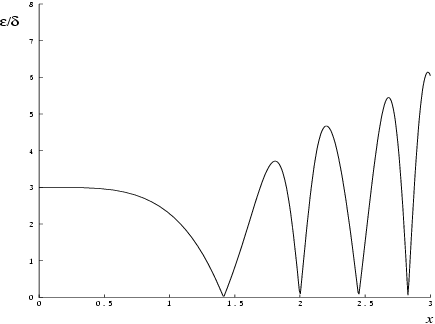NAG Library Function Document
nag_fresnel_s_vector (s20aqc)
1 Purpose
nag_fresnel_s_vector (s20aqc) returns an array of values for the Fresnel integral .
2 Specification
| #include <nag.h> |
| #include <nags.h> |
| void |
nag_fresnel_s_vector (Integer n,
const double x[],
double f[],
NagError *fail) |
|
3 Description
nag_fresnel_s_vector (s20aqc) evaluates an approximation to the Fresnel integral
for an array of arguments
, for
.
Note: , so the approximation need only consider .
The function is based on three Chebyshev expansions:
For
,
For
,
where
,
and ,
with .
For small , . This approximation is used when is sufficiently small for the result to be correct to machine precision. For very small , this approximation would underflow; the result is then set exactly to zero.
For large , and . Therefore for moderately large , when is negligible compared with , the second term in the approximation for may be dropped. For very large , when becomes negligible, . However there will be considerable difficulties in calculating accurately before this final limiting value can be used. Since is periodic, its value is essentially determined by the fractional part of . If where is an integer and , then depends on and on modulo . By exploiting this fact, it is possible to retain significance in the calculation of either all the way to the very large limit, or at least until the integer part of is equal to the maximum integer allowed on the machine.
4 References
Abramowitz M and Stegun I A (1972) Handbook of Mathematical Functions (3rd Edition) Dover Publications
5 Arguments
- 1:
n – IntegerInput
On entry: , the number of points.
Constraint:
.
- 2:
x[n] – const doubleInput
On entry: the argument of the function, for .
- 3:
f[n] – doubleOutput
On exit: , the function values.
- 4:
fail – NagError *Input/Output
-
The NAG error argument (see
Section 3.6 in the Essential Introduction).
6 Error Indicators and Warnings
- NE_BAD_PARAM
-
On entry, argument had an illegal value.
- NE_INT
-
On entry, .
Constraint: .
- NE_INTERNAL_ERROR
-
An internal error has occurred in this function. Check the function call and any array sizes. If the call is correct then please contact
NAG for assistance.
7 Accuracy
Let and be the relative errors in the argument and result respectively.
If
is somewhat larger than the
machine precision (i.e., if
is due to data errors etc.), then
and
are approximately related by:
Figure 1 shows the behaviour of the error amplification factor
.
However if is of the same order as the machine precision, then rounding errors could make slightly larger than the above relation predicts.
For small , and hence there is only moderate amplification of relative error. Of course for very small where the correct result would underflow and exact zero is returned, relative error-control is lost.
For moderately large values of
,
and the result will be subject to increasingly large amplification of errors. However the above relation breaks down for large values of
(i.e., when
is of the order of the
machine precision); in this region the relative error in the result is essentially bounded by
.
Hence the effects of error amplification are limited and at worst the relative error loss should not exceed half the possible number of significant figures.
8 Parallelism and Performance
Not applicable.
None.
10 Example
This example reads values of
x from a file, evaluates the function at each value of
and prints the results.
10.1 Program Text
Program Text (s20aqce.c)
10.2 Program Data
Program Data (s20aqce.d)
10.3 Program Results
Program Results (s20aqce.r)

